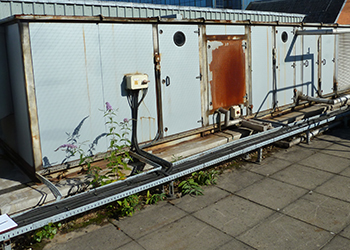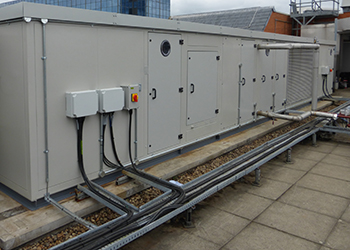No excuses for no maintenance
People offer countless excuses for failing to maintain HVAC plant – ‘It’s too expensive… too disruptive… too timeconsuming… too difficult… too much effort’, the justifications go on. The arguments in favour of maintenance are, however, powerful and the cost is absurdly low when compared with the cost of dealing with a catastrophic equipment failure.
 |
| After maintenance (below) is a vast improvement on the starting point (above) |
 |
Air conditioning components consume enormous quantities of energy – chillers, for example, are responsible for using more than half the energy used on some buildings – so keeping them working at optimum efficiency will effectively contribute to a company’s bottom line.
It also saves energy and therefore operating costs, retains the assets’ value, enhances the business’s reputation, leads to better working relationships and reduces disruption to the business. Increasing energy costs are another good reason to employ an effective maintenance strategy. Best practice maintenance can deliver cost savings of 10% to 40% compared with poor maintenance.
And implementing a maintenance plan will ensure a longer a life for the AC system, reducing total cost of ownership.
But all this begs an important question: how do you go about formulating a plan? Broadly, maintenance improvement is in five steps – determine where you are now (with an audit); decide where you want to get to (what are your critical success factors?); plan how to get there; implement the plan, and return to step one (to complete the continuous improvement cycle).
Here are some tips I’ve developed from my experience over the years with HVAC maintenance. We have also produced a free guide to HVAC system maintenance that includes more details.
• Start with a diagnostic (basically an audit of current maintenance activities) followed by a broad brush initial assessment to identify areas for improvement, then a detailed justification of individual projects selecting specific methods to achieve overall business objectives.
• Good HVAC maintenance begins with a commitment from the top of the organisation to develop a corporate policy on maintenance, repair and overhaul that is unified and clearly communicated. From here, an effective maintenance strategy can be developed with the policies (aims) and strategies (the means for achieving the aims) sometimes combined into a single document.
|
Types of maintenance
|
• A maintenance policy is a written statement that defines the standards to which a building and its services will be maintained. The policy will typically contain a list of the maintenance goals; an outline of the maintenance strategy, and key performance indicators to measure progress in the maintenance programme.
• The maintenance strategy can contain one or a mix of types of maintenance including corrective, preventative, predictive and reliability-centred (see the box).
• Dirty equipment is disproportionately responsible for HVAC equipment failures. A simple cleaning regime will allow fan motors to run more efficiently, coils to remain unsoiled for longer and less frequent changes required for internal filters.
• Good housekeeping practice is part of good maintenance. So, set timers so that there is no cooling when the building is unoccupied. Avoid out-of-hours operation. Check temperature settings. Clean ductwork, fans and grilles regularly.
• Finally, protecting physical assets such as the HVAC system is all very well, but your most important asset is people. Protecting them is paramount so ensure that they can gain safe access to equipment that is to be maintained.
John Grenville is managing director of ECEX







